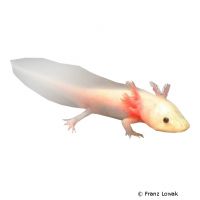Albino Axolotl (Ambystoma mexicanum 'Albino')
| Albino Axolotl Ambystoma mexicanum 'Albino' | |
|---|---|
| Name | Albino Axolotl |
| Name Lat. | Ambystoma mexicanum 'Albino' |
| Synonym | Siredon mexicanum |
| Family | Mole Salamanders |
| Family lat. | Ambystomatidae |
| Order | Salamanders |
| Order lat. | Caudata |
| Origin | Mexico (breeding variety) |
| Habitat | Lakes |
| Diet | Carnivore |
| Behavior | Predatory |
| Keeping | Pair, group |
| Care Level | Easy |
| Breeding | Simple |
| Housing | Aquarium |
| Life Span | 15 years |
| Protection | CITES Appendix II; EU Annex B |
| Metric Units | |
| Size | 30 cm |
| Temperature | 15-18 °C |
| Housing Size | 100 x 60 x 50 cm |
| US Units | |
| Size | 12" |
| Temperature | 59-64 °F |
| Housing Size | 40" x 25" x 20" |
Distribution and habitat
The albino axolotl is a breeding form. Originally they come from a wetland in central Mexico, south of Mexico City. They live there in lakes (Xochimilco and Chalco lakes) and in a system of natural and artificial channels with dense aquatic vegetation. Their habitat is severely threatened by drainage.
Maintenance
Minimum dimensions for the aquarium, according to the size and number of animals
| Floor space in m² for 1-2 animals: GL x 0,01 | Water depth: 1GL |
The total length (GL) is measured at the largest animal. For each additional animal, the footprint shall be increased by 25%. The water depth must not exceed three times the body length of the animal. For 2-4 animals an aquarium of L 100 x W 60 x H 50 cm can be recommended, which should be placed in a quiet and vibration-free place.
They live under water (aquatile) and need an unheated aquarium with strong plants, partly flooding to the water surface, as well as roots, clay tubes and stone structures (caves) as hiding places. An 8-10 cm deep substrate of medium-coarse, round gravel and some subdued light (floating plants) is ideal
Water quality must be that required for average freshwater fish keeping. No ammonia, ammonium and nitrite should be detectable and the nitrate value should not exceed 100 mg/l. To ensure water quality and oxygen content, a filter adapted to the size of the aquarium is required.
| Water temperature | 15-18 °C |
The lighting has to correspond to the species-appropriate day-night rhythm.
Diet
They are voracious lurkers. The food supply consists of live food, such as small fish, earthworms, enchytraea, daphnia, mysis, mosquito larvae, etc., which is also accepted without problems in frozen form, plus commercially available frozen food mixtures, supplemented with high-quality, protein-rich special dry food for axolotls (granules, pellets).
It is recommended to feed small portions several times a day. Regular and varied feeding promotes health and prevents deficiency symptoms.
Reproduction and breeding
They always remain in the larval stage and become sexually mature after 1-2 years (neoteny). The male, recognizable by the distinct cloaca, lays a sperm deposit, which is picked up by the female with the cloaca. A few hours later, the eggs are laid. The eggs, usually several hundred in number, are attached to aquatic plants and furnishings. After deposition, the parents should be transferred to another container. The larvae hatch after 10-20 days and begin to feed independently after another 2-3 days. Suitable food for rearing is freshly hatched brine shrimp (Artemia), cyclops, daphnia and small worms.
Species protection
They are exempt from the obligation to notify (Federal Species Protection Ordinance Annex 5 to § 7 para. 2).
Species protection: WA Appendix II; EU Appendix B. The proof of purchase is the required proof of origin for the animal. Please keep it safe! Your pet store will be happy to provide you with further information.
Important
Permanently higher temperatures above 22 °C lead to weakening of the immune system and make the animals more susceptible to diseases. They remain underwater for their entire lives in the gill-breathing larval stage without completing metamorphosis. The cause is a congenital thyroid defect
Cannibalistic animals have a high regenerative capacity. Severed limbs, even gills and even organs can be replaced. This ability to regenerate almost scarlessly through cell formation makes them interesting for scientific research. The well-being of the animals should be monitored regularly. Temperature should be checked daily, pH, hardness and nitrate levels at least every 14 days. Regular partial water changes are recommended, even if the contaminant level has not yet reached the upper limit. Sudden changes in water quality should be avoided. Newly introduced animals must be accustomed slowly to the water in the aquarium. Further literature can be found in your pet store.
References
Text: Serena Werle; Image: Franz Lowak
Source: ENGELMANN (2006): Zootierhaltung - Tiere in menschlicher Obhut: Reptilien und Amphibien, Harri Deutsch Verlag; VDA & DGHT (2006): Allgemeine Haltungsrichtlinien für Molche und Salamander
- Gemäß § 21 Abs. 5 Tierschutzgesetz idgF
